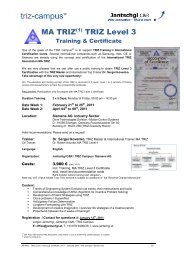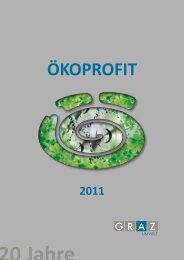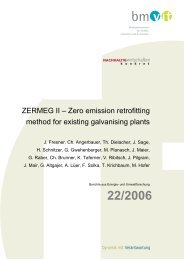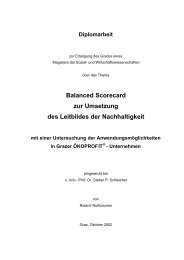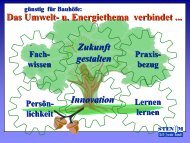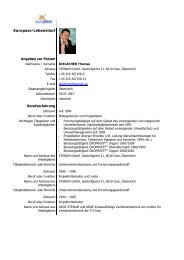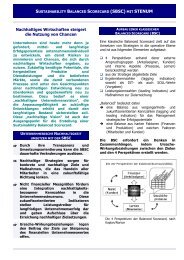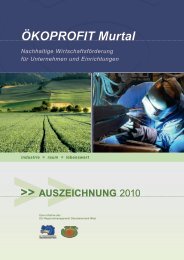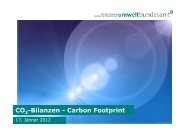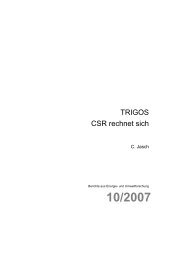Promoting Resource Efficiency in Small & Medium size ... - UNEP
Promoting Resource Efficiency in Small & Medium size ... - UNEP
Promoting Resource Efficiency in Small & Medium size ... - UNEP
Create successful ePaper yourself
Turn your PDF publications into a flip-book with our unique Google optimized e-Paper software.
Segregation<br />
Segregation of waste can offer enhanced opportunities for recycl<strong>in</strong>g<br />
and reuse with resultant sav<strong>in</strong>gs <strong>in</strong> raw material costs. Concentrated<br />
simple wastes are more likely to be of value than dilute or complex<br />
wastes. Mix<strong>in</strong>g wastes can enhance pollution problems. If a highly<br />
concentrated waste is mixed with a large quantity of weak, relatively<br />
uncontam<strong>in</strong>ated effluent the result is a larger volume of waste requir<strong>in</strong>g<br />
treatment. Isolat<strong>in</strong>g the concentrated waste from the weaker waste can<br />
reduce treatment costs. The concentrated waste could be recycled/<br />
reused or may require physical, chemical and biological treatment to<br />
comply with discharge consent levels whereas the weaker effluent could<br />
be reused or may only require settlement before discharge. Therefore,<br />
waste segregation can provide more scope for recycl<strong>in</strong>g and reuse<br />
while at the same time reduc<strong>in</strong>g treatment costs. 64<br />
Step 4: Consider Options<br />
Significant waste reductions can often be achieved by improved operation,<br />
better handl<strong>in</strong>g and generally tak<strong>in</strong>g more care. 65 The follow<strong>in</strong>g list of waste<br />
reduction h<strong>in</strong>ts can be implemented immediately with little or no extra cost.<br />
Specify<strong>in</strong>g and Order<strong>in</strong>g Materials:<br />
Do not over-order materials especially if the raw materials or components<br />
can spoil or are difficult to store. Try to purchase raw materials <strong>in</strong> a form<br />
that is easy to handle, i.e., pellets <strong>in</strong>stead of powders. It is often more<br />
efficient and certa<strong>in</strong>ly cheaper to buy <strong>in</strong> bulk.<br />
Receiv<strong>in</strong>g Materials:<br />
Demand quality control from suppliers by refus<strong>in</strong>g damaged, leak<strong>in</strong>g<br />
or unlabelled conta<strong>in</strong>ers. Undertake a visual <strong>in</strong>spection of all materials<br />
com<strong>in</strong>g on to the site. Check that a sack weighs what it should weigh<br />
and that the volume ordered is the volume supplied. Check that<br />
composition and quality are correct.<br />
Material Storage:<br />
Install high-level control on bulk tanks to avoid overflows and bund<br />
tanks to conta<strong>in</strong> spillages. Use tanks that can be pitched and elevated,<br />
with rounded edges for ease of dra<strong>in</strong><strong>in</strong>g and r<strong>in</strong>s<strong>in</strong>g. Dedicated tanks,<br />
receiv<strong>in</strong>g only one type of material, do not need to be washed out as<br />
often as tanks receiv<strong>in</strong>g a range of materials. Make sure that drums<br />
are stored <strong>in</strong> a stable arrangement to avoid damag<strong>in</strong>g drums while <strong>in</strong><br />
storage. Implement a tank-check<strong>in</strong>g procedure – dip tanks regularly<br />
and document the contents to avoid discharg<strong>in</strong>g a material <strong>in</strong>to the<br />
wrong tank. Us<strong>in</strong>g covered or closed tanks reduces evaporation losses.<br />
Material and Water Transfer and Handl<strong>in</strong>g:<br />
M<strong>in</strong>imise the number of times materials are moved on site. Check<br />
transfer l<strong>in</strong>es for spills and leaks. Is flexible pipe work too long? Catch<br />
dra<strong>in</strong>age from transfer hoses. Plug leaks and fit flow restrictors to<br />
reduce excess water consumption.<br />
Process Control:<br />
Feedback on how waste reduction is improv<strong>in</strong>g the process motivates<br />
the operators – it is vital that the employees are <strong>in</strong>formed of why actions<br />
are taken and what it is hoped they will achieve. Design a monitor<strong>in</strong>g<br />
programme to check the emissions and wastes from each unit<br />
operation. Regular ma<strong>in</strong>tenance of all equipment will help to reduce<br />
fugitive process losses.<br />
Clean<strong>in</strong>g Procedures:<br />
M<strong>in</strong>imise the amount of water used to wash out and r<strong>in</strong>se vessels –<br />
<strong>in</strong>discrim<strong>in</strong>ate water use contributes a large amount to wastewater<br />
flows. Ensure that hoses are not left runn<strong>in</strong>g by fitt<strong>in</strong>g self-seal<strong>in</strong>g<br />
valves. Investigate how wash<strong>in</strong>g water can be conta<strong>in</strong>ed and used aga<strong>in</strong><br />
before be<strong>in</strong>g discharged to dra<strong>in</strong>s. The same applies to solvents used<br />
to clean; these can often be used more than once.<br />
Tighten<strong>in</strong>g up housekeep<strong>in</strong>g procedures can reduce waste<br />
considerably. Simple, quick adjustments can be made to the process to<br />
achieve a rapid improvement <strong>in</strong> process efficiency. Examples of good<br />
housekeep<strong>in</strong>g, <strong>in</strong>clude careful handl<strong>in</strong>g of bags and boxes to avoid<br />
spills; avoid<strong>in</strong>g contam<strong>in</strong>ation by dust and dirt; observ<strong>in</strong>g recipes,<br />
process conditions and dos<strong>in</strong>g recommendations to avoid quality waste<br />
or rework; optimis<strong>in</strong>g works plann<strong>in</strong>g to m<strong>in</strong>imise losses from start<strong>in</strong>g<br />
up, shutt<strong>in</strong>g down or clean<strong>in</strong>g equipment.<br />
7.4 CHECKLIST: Waste m<strong>in</strong>imisation<br />
7.4.1 Dispatch waste<br />
Damaged Products<br />
• Return damaged products to production for repair.<br />
Packag<strong>in</strong>g Material<br />
• Separate waste <strong>in</strong>to paper, plastics and metals. Sell recyclable<br />
materials.<br />
7.4.2 Domestic waste<br />
Canteen<br />
• Modify menu and menu <strong>size</strong> to m<strong>in</strong>imise leftovers<br />
• Make agreements with suppliers to get returnable packages for<br />
the deliveries<br />
• Buy the right amount of foodstuffs<br />
• Compost biodegradable waste<br />
• Collect cook<strong>in</strong>g oil and f<strong>in</strong>d a contractor (waste oil can be<br />
used for fuel, for the production of soap or lubricants or for the<br />
production of biodiesel)<br />
7.4.3 Laboratory waste<br />
Sample Waste<br />
• Assure proper disposal of lab residues<br />
• Reduce sample <strong>size</strong><br />
• Review sampl<strong>in</strong>g procedures<br />
• Return unused sample to process (or client)<br />
7.4.4 Office waste<br />
Waste management<br />
• Recycle or sell empty toner cartridges. In some areas, charity<br />
groups will pick up cartridges for free.<br />
• Avoid the use of disposable batteries, use rechargeable batteries<br />
• Pr<strong>in</strong>t only what is necessary<br />
• Pr<strong>in</strong>t double sided<br />
• Collect waste copies and use them for mak<strong>in</strong>g notes<br />
7.4.5 Production waste<br />
Waste Materials<br />
• Test materials first to determ<strong>in</strong>e whether they can be used <strong>in</strong><br />
current manufactur<strong>in</strong>g processes<br />
64) <strong>UNEP</strong>, Audit and Reduction Manual for Industrial Emissions and Wastes, 1991<br />
65) <strong>UNEP</strong>, Audit and Reduction Manual for Industrial Emissions and Wastes, 1991<br />
70



